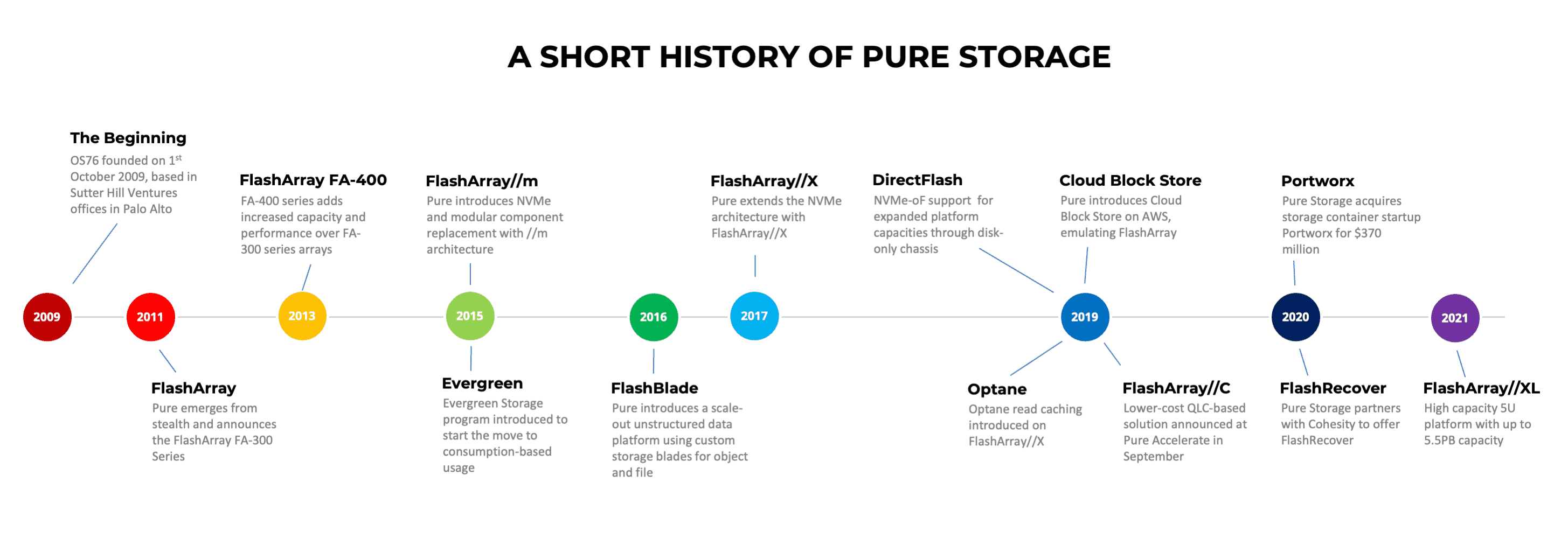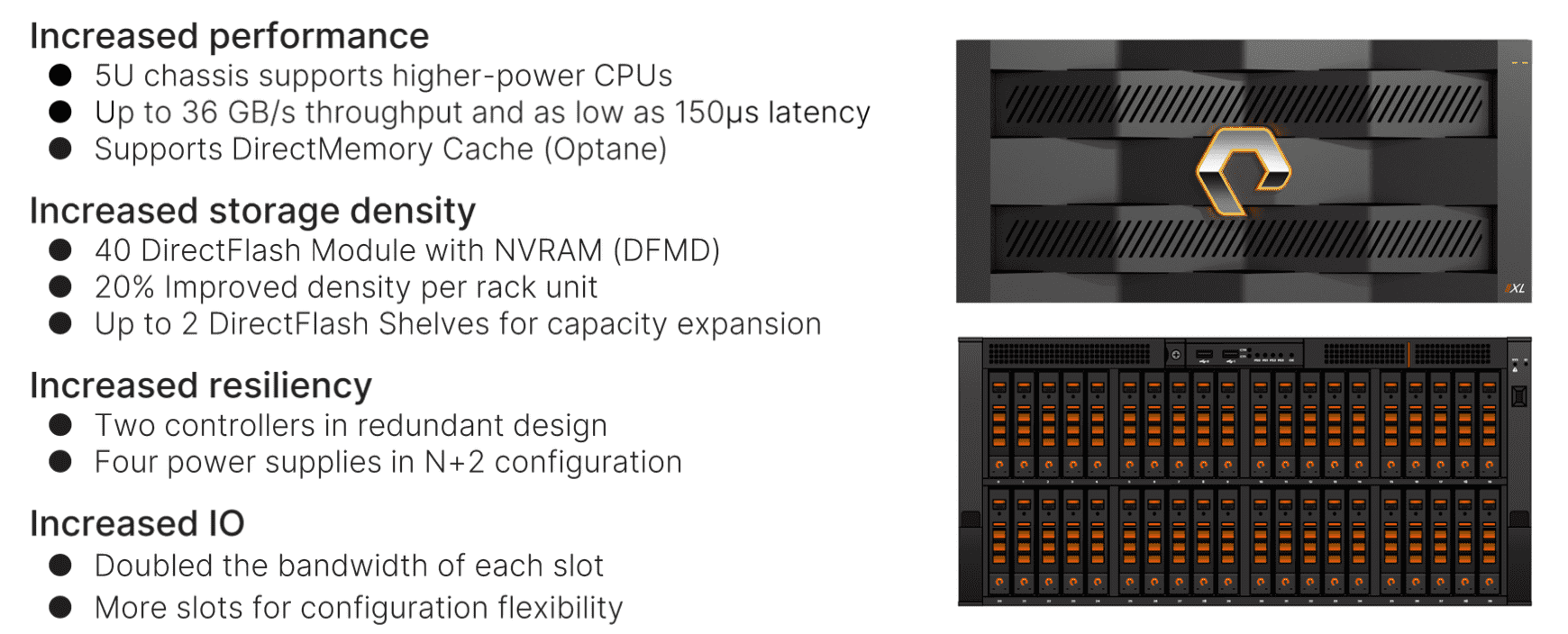This week, Pure Storage announced the availability of a new platform, branded FlashArray//XL, which (as you might guess) is a high-capacity version of the FlashArray//X. At least, at first glance that might be the obvious difference, but under the covers, there’s a lot more.
Background
It’s been ten years since the first FlashArray hit the market. The original FA-300 series was superseded by the FA-400 in 2013, FlashArray//m in 2015 and FlashArray//X in 2017. FlashArray//X R3 went GA at the beginning of 2020, introducing DirectMemory modules and performance upgrades over the previous //X R2 hardware.

FlashArray//X R3 systems are based on Intel Xeon Cascade Lake processors, which were preceded by Skylake (although from memory, I don’t remember Pure being explicit about the processors in the R2). FlashArray//XL systems will be based on Intel Xeon Ice Lake, which represents a performance boost but also the ability to use PCI Express 4.0 and effectively doubles I/O throughput compared to previous architectures.
The benefit of the internal architecture improvements is an increased throughput of up to 36GB/s on //XL systems compared to today’s //X models (at up to 20GB/s). Unfortunately, the side effect of using high-end Xeon Platinum Ice Lake processors is an increase in the thermal profile by around 31% at the top end of the processor family (270W compared to 205W), which pushes the //XL into a 5U rather than 3U chassis used in current models. In reality, this isn’t an issue for customers that have the need for multi-petabyte configurations, as the rack density is actually better on //XL compared to the current high-end //X90. Additional technical specifications may be found here (link).

Goodbye NVRAM
The introduction of //XL sees the end of dedicated NVRAM drives. Previously, NVRAM was used to manage write consistency across controllers before committing to persistent flash. Now, a proportion of some flash modules is configured as SLC and utilised as an NVRAM replacement. This frees up some space, enabling Pure to deploy two layers of DirectFlash modules (40 in total) in the 5U enclosure.
In scalability terms, distributing the NVRAM across drives presumably provides greater throughput while offering the capability to dynamically scale the SLC component based on predicted customer demand.
DirectMemory module support is improved in the new release of Purity (6.2), enabling prioritisation of the Optane cache to specific volumes and volume groups.
Side note: FlashArray lab-based systems run on Optane as a way of testing the full performance capabilities of the system.
Purity 6.2
Additional improvements in Purity 6.2 include increased numbers of volumes to match the scale in capacity, plus the default enablement of SafeMode for ransomware protection of snapshots. One interesting aspect of the SafeMode improvements is the use of an inbuilt timer that doesn’t depend on external time sources to determine when snapshots should expire. As we discussed in a post earlier this year, ransomware attacks evolve and now include tricks such as adjusting NTP servers to artificially expire immutable snapshots. SafeMode protects against these kinds of attack vectors.
Fusion
The FlashArray//XL platform is a performance and capacity upgrade in line with the latest and greatest processor architecture from Intel. At some point in the future, we should expect the Ice Lake architecture to permeate down to //X and //C platforms, depending on how Pure decides to manage the power requirements of this processor family.

In the meantime, //XL provides Pure Storage with a way to extend the top-end capacity and performance requirements of customers while minimising the footprint required in the data centre. Ordinarily, in large enterprises, the job of fleet management would be incumbent upon the customer. As Pure Storage transitions new and existing customers to the Fusion model, these responsibilities fall on Pure’s operational team.
The Architect’s View™
With a wider portfolio of offerings, Pure Storage can now consolidate larger customers into a smaller number of platforms. The additional performance improvements allow for greater application density where the IOPS/GB ratio can be pushed a little harder. Flexibility of platform choice allows the company to pick the right chassis for the customer at the time of deployment, then vary the infrastructure as required over time. These capabilities (as well as the ability to reuse and mix and match storage capacity) provide operational and financial flexibility in a world moving towards capacity and service-based consumption. The only small caveat is that the 5U configuration uses controllers with a different form factor, so only the DirectFlash modules will be backwards compatible between //XL and //X.
Although we may not realise it, continuous improvement is one benefit that can easily be delivered through public cloud infrastructure. The same can’t be said for on-premises solutions where in many cases, a forklift upgrade is required. Server virtualisation took away a lot of the heavy lifting that previously would have required days and weeks of effort.
However, storage still remains a logistical challenge due to data inertia. The hypervisor can help, but we need I/O offload and for the storage to take on the responsibility of data balancing, not the hypervisor layer. If we want the future of on-premises infrastructure to have the same flexibility as the public cloud, then storage upgrades and refreshes need to be as transparent and non-impacting as moving to the latest block storage offering.
Pure Storage continues to evolve its story around this key requirement and so differentiates from the competition in the market. This goes part-way to explaining why the company posted yet another financial quarter of growth and inches ever closer to profitability. While on-premises block storage may not be seen as a growth area, Pure Storage continues to take share from incumbents like Dell, where storage hardware revenue has been flat for many years. The key to this success has been constant improvements in performance, capacity and capabilities, while (crucially) operating a single interoperable platform.
Copyright (c) 2007-2021 – Post #dede – Brookend Ltd, first published on https://www.architecting.it/blog, do not reproduce without permission. Disclaimer: Pure Storage is a podcasting client of Brookend Ltd.

